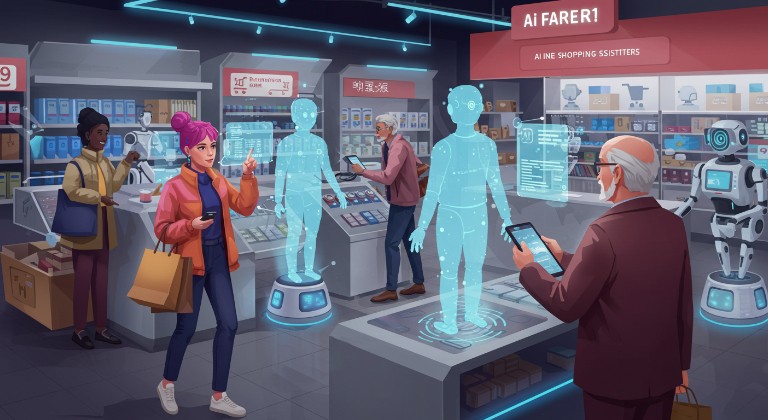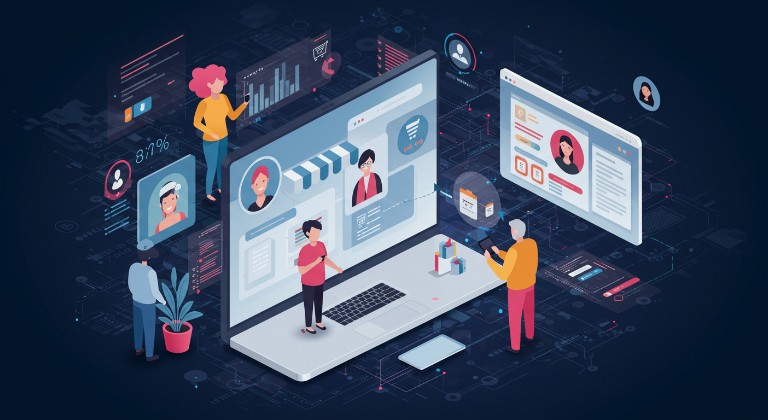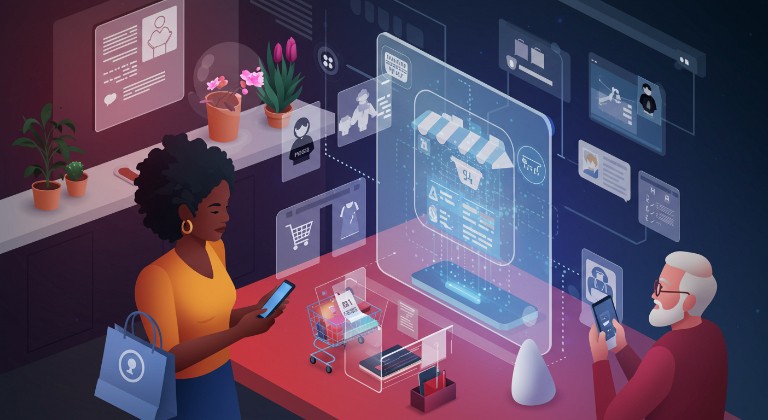The e-commerce world is rapidly evolving, and artificial intelligence (AI) is the engine driving this transformation. As we look toward 2025, the role of AI in reshaping online shopping experiences becomes clearer. From hyper-personalization to augmented reality, the innovations are endless. But what does this mean for you as a business owner or a tech enthusiast? Let’s explore the trends that will redefine the future of AI in e-commerce.
Table of Contents
What is the Future of AI in E-commerce?
AI is no longer a futuristic concept—it’s here, and it’s a game-changer. By 2025, AI will:
- Revolutionize customer interactions with AI-powered chatbots and virtual assistants.
- Optimize inventory management through predictive analytics.
- Enhance product discovery using tools like visual search and augmented reality (AR).
Imagine a customer searching for a winter jacket. With AI, the experience is no longer a simple keyword search. Instead, AI analyzes their past purchases, preferences, and even weather patterns to suggest the perfect product. These capabilities make shopping more intuitive, efficient, and engaging than ever before.

Key AI Trends Shaping E-commerce in 2025
- Generative AI
- Generative AI tools create personalized content, from product descriptions to marketing emails.
- Example: Adobe Sensei generates unique, data-driven promotional materials tailored to individual shoppers.
- Hyper-personalization
- AI will use real-time data to deliver tailored shopping experiences.
- Tools like Nosto analyze user behavior to suggest products, ensuring every interaction feels bespoke.
- Dynamic Pricing
- AI enables businesses to adjust prices dynamically based on demand, competition, and customer behavior.
- Tools like Prisync automate competitive pricing strategies.
Table: Comparison of AI Tools for Personalization
| Feature | Nosto | Adobe Sensei |
|---|---|---|
| Real-time Data | ✓ | ✓ |
| Predictive Analytics | ✓ | ✓ |
| Platform Integration | Shopify, Magento | Adobe Commerce |
How Will Generative AI Transform Online Shopping by 2025?
Generative AI is your secret weapon for creating:
- Unique product descriptions that boost SEO rankings.
- Custom marketing campaigns targeting specific customer segments.
For instance, an AI tool could craft a personalized email for a returning customer, highlighting items left in their cart and suggesting complementary products. This not only enhances the shopping experience but also drives conversions.
The Impact of Hyper-personalization on Customer Experience
Hyper-personalization goes beyond simply addressing customers by their first names. It’s about:
- Tailoring product recommendations based on browsing history.
- Offering personalized discounts during flash sales.
Think of it as having a virtual stylist or assistant who knows you better than you know yourself. Shoppers are increasingly expecting businesses to anticipate their needs, making hyper-personalization not just an advantage but a necessity in competitive markets.
Benefits of AI-Powered Tools in E-commerce
- Chatbots and Virtual Assistants
- Tools like Lyro AI Chatbot offer 24/7 customer support with natural language processing.
- These chatbots handle routine inquiries, freeing up human agents for complex tasks.
- Inventory Management
- Tools like Prediko help Shopify brands forecast inventory needs, reducing overstock and shortages.
- Predictive analytics ensures better stock rotation and minimizes waste.
- Fraud Detection
- Platforms like Signifyd protect businesses with real-time fraud prevention solutions.
- AI detects suspicious transactions faster and more accurately than manual reviews.
Visual Search and Augmented Reality (AR) for Product Discovery
By 2025, visual search and AR will transform how customers discover products:
- Visual Search: Customers can upload photos to find similar items. Pinterest Lens is leading the charge in this space, making it easier for shoppers to find exactly what they want.
- AR: Tools like IKEA Place allow users to visualize furniture in their homes before purchasing. This eliminates guesswork and increases customer confidence.
These innovations make shopping not only interactive but also enjoyable, helping businesses stand out in a crowded market.

Challenges of Integrating AI into E-commerce Platforms
While AI offers endless opportunities, challenges remain:
- High implementation costs. Smaller businesses may struggle to afford cutting-edge tools.
- Data privacy concerns. Customers are increasingly wary of how their data is used.
- Complexity in integrating AI tools with existing systems. Seamless integration requires technical expertise and careful planning.
Despite these hurdles, AI’s benefits far outweigh the challenges, especially as more affordable solutions enter the market.
How Can Small Businesses Compete Using AI?
AI isn’t just for the big players. Affordable and accessible tools make it possible for smaller retailers to compete:
- Use Tidio for customer service, combining chatbots with human support.
- Leverage Prisync for dynamic pricing to stay competitive.
- Optimize marketing with HubSpot AI-driven campaigns that target the right audience at the right time.
Even with limited resources, small businesses can harness AI to deliver exceptional customer experiences and drive growth.
Conclusion: The future of AI in e-commerce
The future of AI in e-commerce is thrilling, with endless possibilities to enhance shopping experiences, streamline operations, and boost profitability. By 2025, trends like generative AI, hyper-personalization, and AR will redefine the industry. The key to staying ahead lies in adopting these innovations early and adapting to changing consumer expectations.




